| CHARTWATCHERS |
| Spring Savings Are Here, With A Very Special Twist... |
| by Grayson Roze |
|
 Hello Fellow ChartWatchers! Hello Fellow ChartWatchers!
The springtime sun is shining bright here in the Pacific Northwest, and we think that's cause for celebration. So, I'm coming to you this week with a very special announcement.
For a limited time only this month, we're giving you 2 FREE months of StockCharts service when you sign up or renew for a 12-month subscription. That means you can save up to $80 off our regular subscription prices.
If you're a current StockCharts Member and love the service, you can extend your existing subscription now and save. If you're not a member, but you've been thinking about signing up, this is the ideal time to do so.
But there's an exciting twist...
As a special bonus for those of you who take advantage of our Spring Special, we're going to give you exclusive access to the latest preview edition of StockChartsACP – our new advanced, interactive financial charting platform.
We've hinted at the upcoming release of ACP (Advanced Charting Platform) throughout the past month, and Chip even previewed some of the new technology during last month's 20th anniversary celebrations on StockCharts TV. It's been a tough secret to keep though! Our development team has been hard at work for over 18 months building one of the biggest features in our company's history. With an ultra-dynamic, highly-interactive charting experience, ACP will transform the way you view the financial markets. It's the next generation of StockCharts, and we absolutely cannot wait to show it to you.
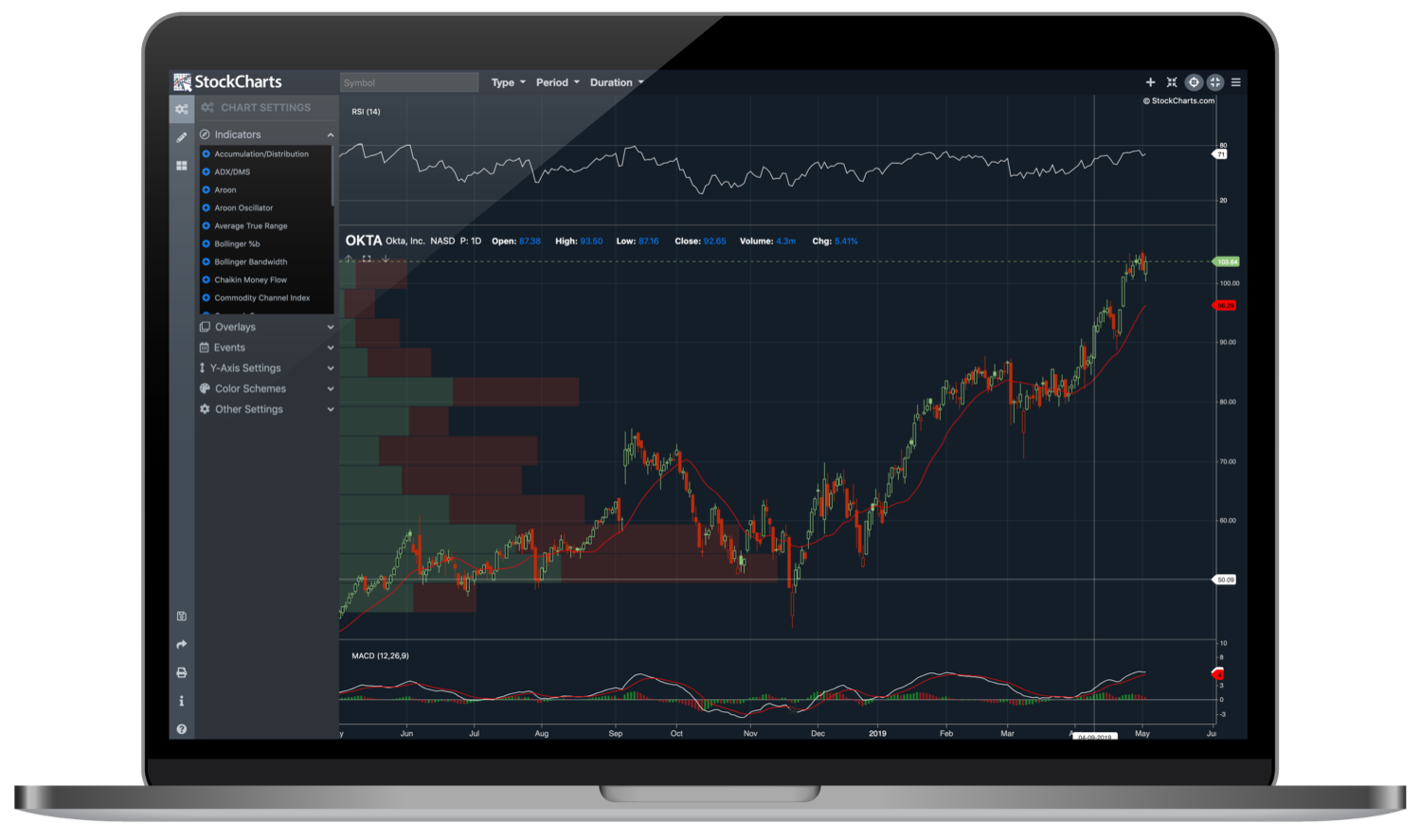 After our Spring Special ends, we'll send out an exclusive link with access to the latest StockChartsACP demo. The official release of ACP will come later this summer, but the newest technology preview will give you a taste of how powerful the platform will be. If you sign up for the Spring Special now, you'll receive your 2 free months of service AND access to this exciting new feature preview at the end of the sale! After our Spring Special ends, we'll send out an exclusive link with access to the latest StockChartsACP demo. The official release of ACP will come later this summer, but the newest technology preview will give you a taste of how powerful the platform will be. If you sign up for the Spring Special now, you'll receive your 2 free months of service AND access to this exciting new feature preview at the end of the sale!
If you're a StockCharts Member...
If you're a StockCharts Member and would like to take advantage of this special offer, log into your account and then CLICK HERE. Once you complete the Spring Special checkout process, your 2 free months will be added to the end of your existing service. Easy!
If you're not a member...
If you're not currently a StockCharts Member, now is the perfect time to sign up! You can take advantage of our Spring Special by first signing up for a 1-month free trial. Then, once your trial account is active, you can log in and sign up for our Spring Special. The 2 free months will added to the end of your new service period. To learn more and get started, CLICK HERE.
Remember, this Spring Special will only be around for a short period of time. Don't miss your chance to save with 2 free months of service AND receive exclusive access to the latest preview of StockChartsACP!
Until next week,
Grayson Roze
Business Manager, StockCharts.com
Author, Trading For Dummies
|
| READ ONLINE → |
|
|
|
| The Market Message |
| Strong Jobs Report Boosts Stocks - S&P 500 Nears Another Record |
| by John Murphy |
Editor's Note: This article was originally published in John Murphy's Market Message on Friday, May 3rd at 1:34pm ET.
A surprisingly strong jobs report this morning has given stocks a big boost today. All major indexes are having a strong day with the Nasdaq and small caps in the lead (more on that shortly). Transports are also have an especially strong day which is another positive sign. All eleven stocks sectors are in the black led by energy, cyclicials, financials, and industrials. Weaker sectors include more defensive utilities and REITS. Emerging markets are leading foreign stocks higher, with Chinese stocks in the lead. Bond yields are pulling back today. Chart 1 shows the S&P 500 bouncing off its 20-day average (green line) which puts it in position to regain its record move over its September high at 2940.
Chart 1
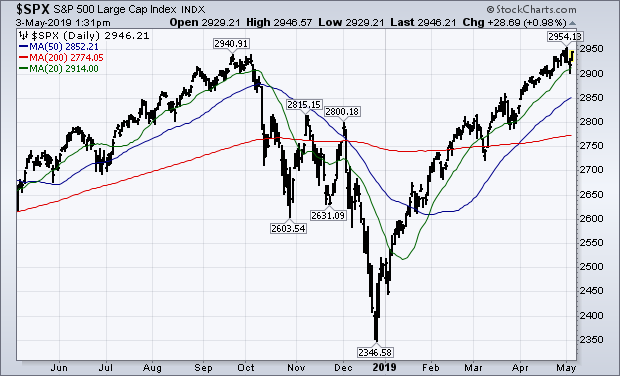
|
| READ ONLINE → |
|
|
|
| Art's Charts |
| Improving the Best Six Months Strategy by Adding Months and Timing |
| by Arthur Hill |

The "Best Six Months" strategy suggests that the best time to own stocks is from November to April, and the worst time is from May to October. Testing over the last 25 years confirms the performance differences between these two periods, but this strategy still leaves money on the table. This article will show that a "Best Eight Months" strategy outperforms the Best Six Months strategy. Furthermore, this strategy can be improved with market timing and switching to the 20+ YR T-Bond ETF (TLT) during the worst four months.
Yale Hirsch developed the Best Six Months strategy in the 1950s and this is one of many strategies covered by the Stock Trader's Almanac, which is a great resource. Jeffrey Hirsch currently runs the almanac and regularly updates the Best Six Months strategy using the Dow Industrials and MACD for market timing.
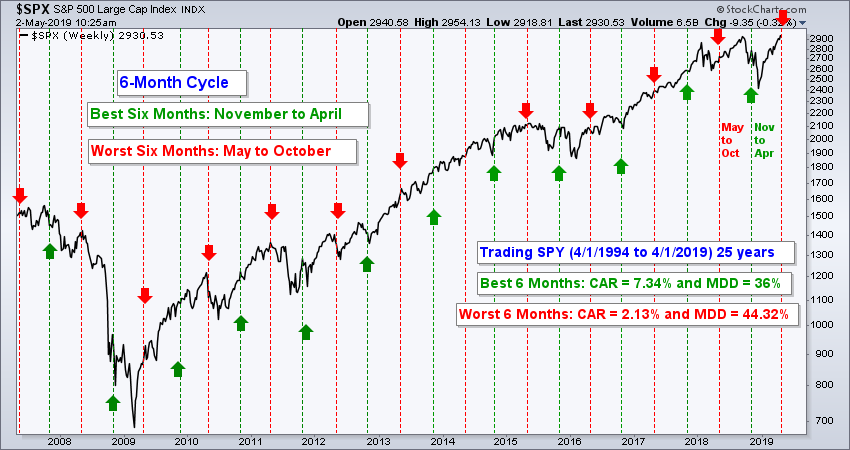
The chart above shows these periods with the green lines marking the start of the best six months and the red lines marking the start of the worst six months. Putting these periods to the test, the best six months has a clear advantage. Using total return SPY for trading, the Compound Annual Return was more than three times higher for the best six months (7.34% vs. 2.13%) and the Maximum Drawdown was lower (36% vs. 44%).
A look at the seasonality chart suggests that we can extend the best six months to the best eight months. Over the last 20 years, the S&P 500 closed higher 65% of the time in May and 63% of the time in October. In addition, the four month period from June to September was the worst four month stretch over the last 20 years. On average, the S&P 500 was higher just 56.75% of the time during these months. Furthermore, the sum total of the average gain/loss was a loss (-1.3%). The numbers at the bottom of each histogram bar show the average gain/loss for the month (-1.0, + 0.8, -0.1, -1.0).
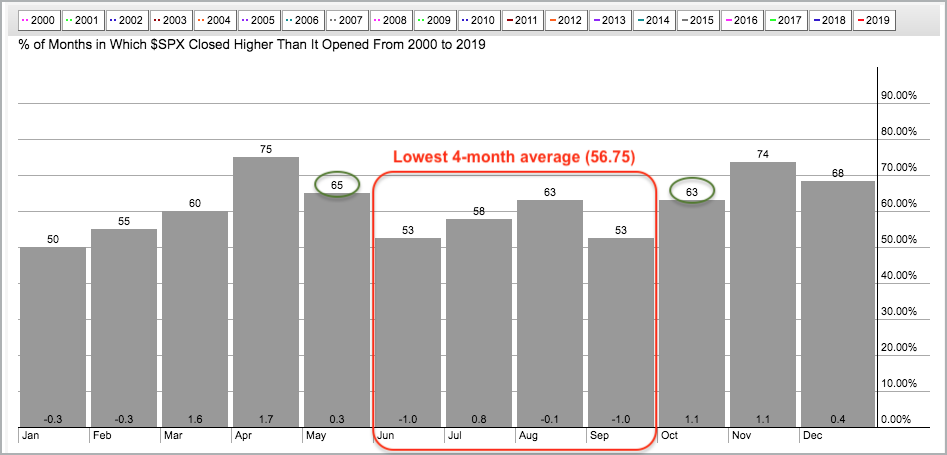
The chart below shows an example of the best eight months as well as some backtest results. Trading SPY over a 25-year period from April 1994 to April 2019, the best eight months outperformed the worst four months with a much higher Compound Annual Return (9.92% vs. 0%). The Maximum Drawdowns were both high though.
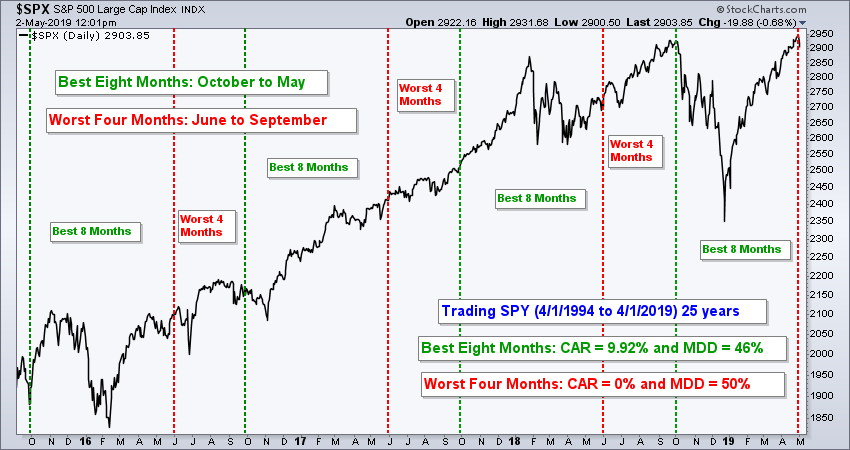
The best eight months strategy clearly outperforms the best six months and adds value, but the Maximum Drawdown needs improvement. Some simple market timing may do the trick. The strategy is to buy SPY when the best eight months period is active and the 20-day SMA for the S&P 500 is above the 200-day SMA. The position is sold when the worst four months period begins OR when the 20-day SMA for the S&P 500 moves below the 200-day SMA. Note that the 20-day SMA for the S&P 500 could be above the 200-day SMA on June 1st, but the position would still be closed because the worst four month period began.
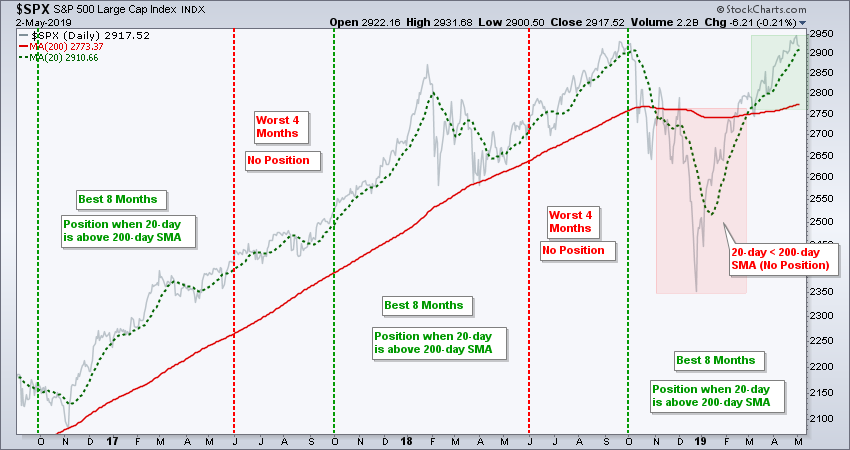
Now let's compare three different strategies over a 25 year period. The first is a simple strategy that buys and sells SPY based on the 20/200-day cross for the S&P 500. The second goes long during the best eight months and goes to cash during the worst four months. The third strategy combines the best eight months with the moving average signals for the S&P 500. Note that the S&P 500 is used for signals to prevent dividend drift and SPY is the trading vehicle so we can calculate the total return (dividends included). This is explained in the video (see below).
The system on the last line of the table below buys SPY when the best eight months period is active and the 20-day SMA for the S&P 500 is above the 200-day SMA. The system sells when the worst four month period is active OR the 20-day SMA for the S&P 500 is below the 200-day SMA. Using a trend filter reduced the Compound Annual Return to 8%, but the Risk-adjusted Return (16.65%) was the highest because the system was invested just 48% of the time. In addition, the market timing filter greatly reduced the Maximum Drawdown and it was the lowest of the three.

When using the best eight months strategy with $SPX timing, chartists can consider an alternative to stocks when in cash (48% of the time). The 20+ YR T-Bond ETF (TLT) is a natural alternative during the worst four months and I also put this ETF to the test. You can learn more about the TLT addition in this week's On Trend video on Youtube. I also compare these systems to buy-and-hold as well as a basic moving average crossover system. Click here to watch.
Programming note: correction from Thursday's show and video. Some of the key metrics for the Best Eight Months with Market Timing and TLT were not correct on Thursday. I found a code error Friday morning, corrected the signals and revised the video. The key metrics are not as good, but still good enough to consider as a strategy, especially when considering the risk-adjusted returns.
Arthur Hill, CMT
Senior Technical Analyst, StockCharts.com
Author, Define the Trend and Trade the Trend
Want to stay up to date with the latest market insights from Arthur?
– Follow @ArthurHill on Twitter
– Subscribe to Art's Charts
– Watch On Trend on StockCharts TV (Tuesdays / Thursdays at 10:30am ET)
|
| READ ONLINE → |
|
|
|
| The Canadian Technician |
| Some Sector Rotation Is Starting To Appear |
| by Greg Schnell |
With most of the large caps finished reporting, it's a good time to take a look and see what is working. Over the last two weeks, Health Care, Utilities, Financials and Real Estate have outperformed the big growth sectors of Communications and Technology.
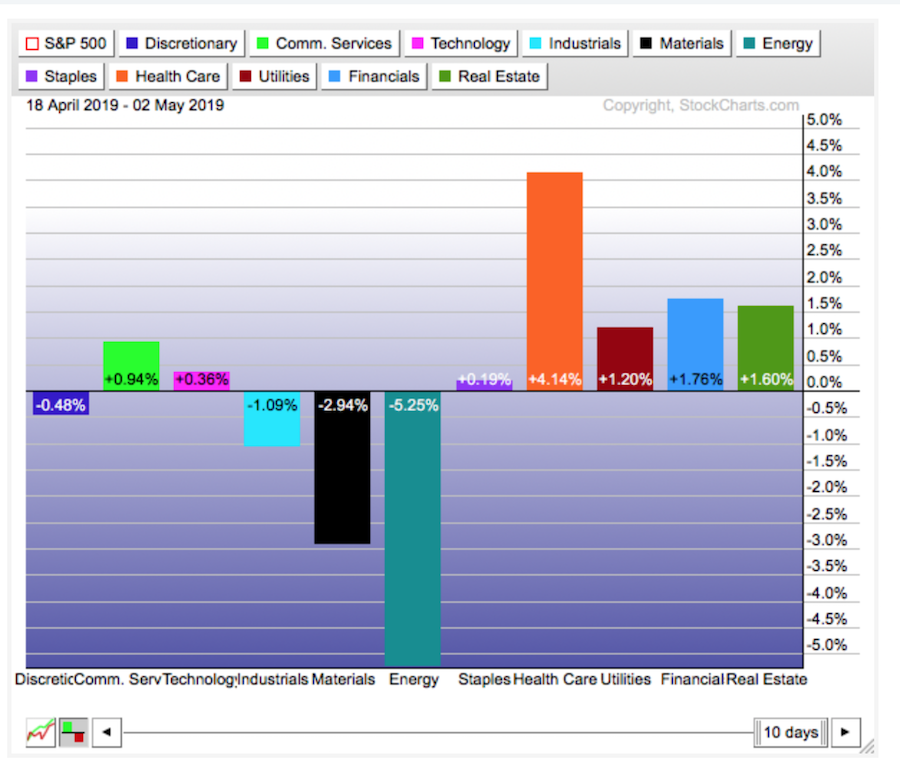
While that can happen from time to time, it surprises me that it is happening just as Apple announces a $75 Billion buyback, Facebook and Microsoft both posted great numbers and Amazon makes a run at $2000.
More concerning is the fact that these fabulous earnings are struggling to pull the broader market up.

Looking at the RRG Chart, it is very clear that the tech stocks have been doing the heavy lifting to push this market to new highs. Even though both Apple and Microsoft are in the $INDU, that group is underperforming the all world index (AWCI).
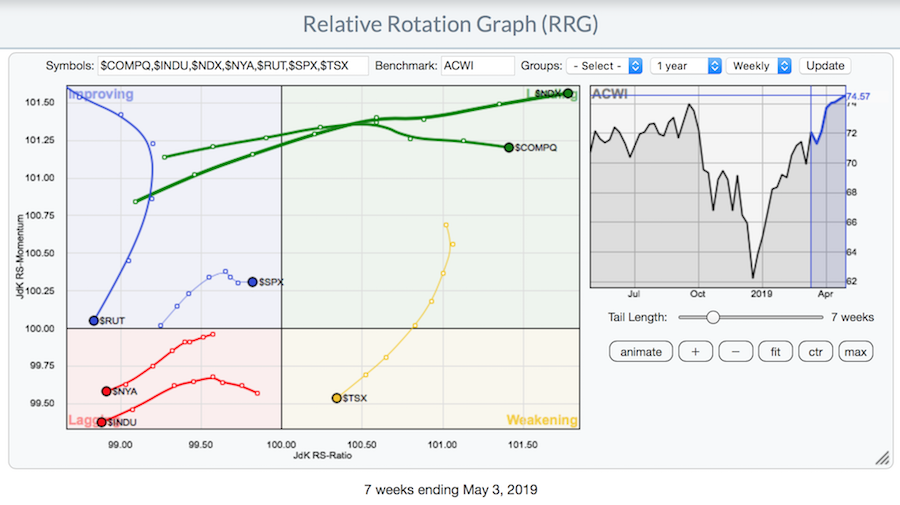
Tech is still driving the macro picture, as shown by the $COMPQ and $NDX being pinned in the top right corner of the RRG. If the short-term rotation to defensives continues, I would keep an eye out for rollovers in the big-name stocks. Seeing the $NYA in the bottom corner is not comforting.
The real issue is whether global growth can start to accelerate - the next chart says "not yet." The rest of world ETF (VEU) is particularly interesting at this level, gently nudging to try and take out the September 2018 level. It has spent 6 weeks going nowhere, so we'll see if this can start to improve.

Currently, the net new highs and advance/decline data suggest that the US market has enough strength to make higher highs. Meanwhile, the Canadian market is struggling. US investors can take advantage of being in the strongest market in the world by watching how related markets start to fail. Currently, Canada looks very weak. It continues to look like the bulls are in charge, but the defensive players are starting to take up some of the ice.
I have a lot of information on video that can be found on the StockCharts YouTube channel. The most recent edition of Market Buzz discusses the Canadian market weakness, as well as how to sort through the Nasdaq 100 using different indicators.
Good trading,
Greg Schnell, CMT, MFTA
Senior Technical Analyst, StockCharts.com
Author, Stock Charts For Dummies
Want to stay on top of the market's latest intermarket signals?
– Follow @SchnellInvestor on Twitter
– Connect with Greg on LinkedIn
– Subscribe to The Canadian Technician
|
| READ ONLINE → |
|
|
|
 |
| Earnings Beats |
| Profiting from Pullbacks |
| by John Hopkins |
When you're a bull, the last thing you want to see is a pullback in stocks you own. This is understandable - who wants to see something they own lose value? But, at some point, the market and individual stocks will get overheated, so instead of worrying about a pullback, try to identify those stocks that are likely to get the most attention on any selling.
A perfect example is Microsoft, a company that recently beat earnings expectations, moved up nicely, got overbought and could prove to be a solid reward-to-risk trade at the right price.
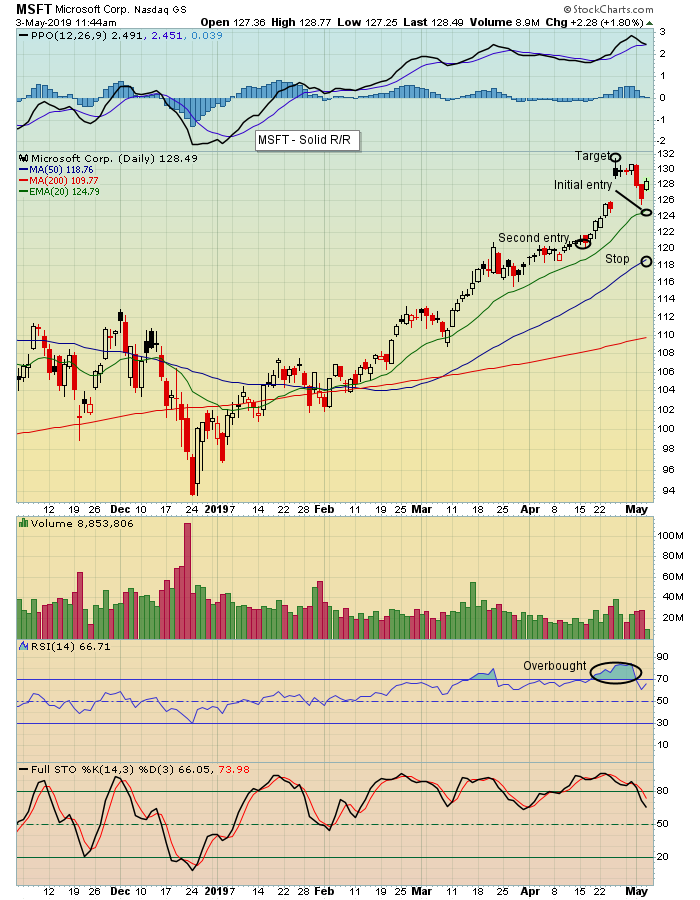
You can see on the chart above how stretched the stock got; look at that blue RSI cluster as the RSI neared 90, signaling an extreme overbought condition. Now, the question becomes this: what might be an appropriate entry point? The first key level of technical support is right near the $125 level, which might warrant some nibbling. Then, there's the price support in the $120 range. For those more conservative, you might perhaps wait to see if it falls even further. The 50-day moving average is right around $119, an exit point if it closes below that level. You might even think about averaging down, which would be a middle-of-the-road strategy that reduces your cost basis.
The point here is MSFT is the type of stock that traders are likely to gravitate to on any decent pullback. Earnings were strong and many traders will see the stock as a safe haven should the overall market fall further. There are many stocks like MSFT that recently beat earnings, hit new all time highs, got overbought and will be sought after at the right time. In fact, we currently have 255 stocks on our Strong Earnings ChartList, many of which look similar to MSFT that we'll be watching closely for high reward-to-risk entry levels. If you would like to see the full list, just click here.
Q1 earnings season is mostly in the rearview mirror now. Those companies that traders care about the most have already posted their numbers. With any luck, we'll see some selling at some point soon while keeping an an eye on those companies that exceeded expectations, which could set up nicely for solid gains.
At your service,
John Hopkins
EarningsBeats
|
| READ ONLINE → |
|
|
|
| The Traders Journal |
| Interdisciplinary Investing: Combining Fundamentals and Technicals Increases Profits |
| by Gatis Roze |

How does a return of 14% in six months sound to you? Last February, I wrote a blog about attending the unique interdisciplinary DENT Conference last year in Napa Valley. I credit my attendance there with directly re-energizing and reimagining my investing over the six months that followed. This past February, Jonathan Levin, Dean of the Stanford Graduate School of Business, spoke to a group of fellow alumni here in Seattle. He told us that one of the Business School's biggest strategic initiatives today is joint interdisciplinary studies with Stanford's Schools of Engineering, Behavioral Science, Law and Medicine.
This notion reinforces precisely the message that I heard at the DENT 2019 Conference held recently in Santa Fe. Here’s why I feel an interdisciplinary approach is also essential for investors. I felt re-energized once more after my time in Santa Fe, and it’s my objective to reproduce or surpass that 14% gain over the coming six months in 2019. So far, looking strong!
As technicians, we like to say "it’s all in the charts". Yes, there is truth in that. But as our book, Tensile Trading clearly shows, there are 10 essential stages to achieving stock market mastery. An interdisciplinary approach provides a significant contribution to reaching that pinnacle.
This year's DENT Conference presented over two dozen extraordinary speakers. I'd like to highlight only a few of their insights and then add some key observations of my own.
The first speaker to impress me was Maria Konnikova — an Ivy League educated PhD who has written two New York Times best-selling books exploring real life applications of psychology. In researching her newest book, she became intrigued with the interplay of skill and chance in professional poker as its relates to game theory.
In the past, I’ve written various blogs using poker as a great metaphor for successful stock market investing. Dr. Konnikova’s observations reinforced my own thesis on the value of understanding poker. In her effort to examine the mind’s responses to conditions involving both skill and chance, she committed herself to learning a totally new craft — poker. Within a year of learning it, she earned $230,000 and won a major international championship title. An amazing feat!
She talked; I listened. Here are her five key observations on learning a new skill and understanding how luck plays its part.
- Make a serious disciplined commitment. Total immersion in a new subject is powerful.
- The intrinsic motivation within your “inner self” is far more potent than extrinsic rewards —such as poker winnings or stock market gains.
- Self reflection of the brutally-honest variety is imperative. You must be willing to truly know thy self — thereby embracing your personal strengths and weaknesses. (see Chapter 3 of Tensile Trading).
- Leverage your skill set. Know your edge and how you’ll react emotionally to different scenarios. Be willing to accept feedback, and use feedback to make appropriate adjustments.
- Expect the unexpected. Luck does indeed happen. Embrace it when it’s positive. Acknowledge it when it’s negative. Recognize that you cannot control everything. You can only control the probabilities.
Another notable DENT speaker was the renowned graphic designer, Roger Black, who gave us an enlightening history of printed communication— from early calligraphy through the advent of printing to desktop publishing and designing by bots today. His lecture made my head spin, and I felt some of his remarks were particularly appropriate for investors.
- You must serve an apprenticeship of learning before you can ever be considered proficient.
- Observe in detail. You need to be uniquely ambidextrous in today’s world. Grasp the here and now, but have a clear vision of the future.
- Whatever sandbox you play in, you should assume that it will change. Embrace and enjoy the state of flow in your sandbox. Bring with you the most appropriate tools and toys, but have fun with the changes.
- Learn from history and look for patterns. Patterns from the past will recur with amazing regularity.
We also heard from Gary Shapiro who is President and CEO of the Consumer Technology Association which hosts CES each year— the largest trade show in the world representing 2,200 consumer technology companies. His two books on "Ninja Management" explore the importance of scenario planning, among many other topics.
In extrapolating his management theories to investing, it’s clear to me that "stock market Ninjas" also need to layout in detail both bullish and bearish scenarios for every one of their positions. Ninjas in the corporate world need to look out for their competitors. Similarly, Ninjas in the stock market arena need to be fixated on their portfolio positions.
Interestingly, Shapiro said the most common attribute he sees in successful corporate Ninjas is curiosity. I think investor Ninjas also must employ an unending curiosity as it relates to change and evolution in all corners of the stock market.
In closing, I'd like to invite you to explore next year’s DENT 2020 Conference — wherever it might be held. I'm sure you'd profit mightily from the experience, the people, and the contagious enthusiasm of interdisciplinary passions.
I'll sign off with two favorite quotes from the conference and some concluding observations of my own:
"The best decisions are made when you're rested, exercised and healthy. It also helps to not be fixated on the weeds or you'll never pop out of them."
— Danielle Morrill, Founder, Mattermark
"Don’t silo your thinking. That's old-mode thinking."
— Sarah Boisvert, FabLabs
From my own notepad:
- Foundations matter, and they always take time to build. There are no shortcuts. Like other disciplines, the stock market demands an apprenticeship.
- Routines matter. A few profitable trades is not the same as consistent success.
- You need to get your "Investor Self" down pat. Practice mental discipline.
- The stock market — like poker — is a game of incomplete knowledge. That is why artificial intelligence will never solve it.
- As the cliche says, "you are the company you keep". Therein lies the challenge. Keep company with people from all disciplines and walks of life who can help make you a more astute investor.
Trade well; trade with discipline!
- Gatis Roze, MBA, CMT
StockMarketMastery.com
|
| READ ONLINE → |
|
|
|
|
|
| DecisionPoint |
| Volume Ratio Charts - Climactic Attention Flags |
| by Erin Swenlin |
My dad, Carl Swenlin, was a guest on MarketWatchers LIVE last Wednesday (here is a link to that show). He brought in some DecisionPoint indicator charts that I hadn't looked at in quite some time (truth be told, he hadn't looked at them in awhile either) and many of our viewers asked about how to obtain them. One of the ChartLists in the DecisionPoint Market Indicators ChartPack is labeled "Volume Ratios" - it's actually a very elegant indicator in its simplicity. What surprised us both was the timeliness of the attention flags that the climactic readings presented.
Here are the charts that Carl brought to the show:
Below, we have a very-short-term chart of the ratios. Basically, the ratios are total Up volume divided by Down volume and vice versa. We can see peaks here, but they aren't really as climactic as they might seem. It is far more obvious on longer-term charts what a climactic reading really is.
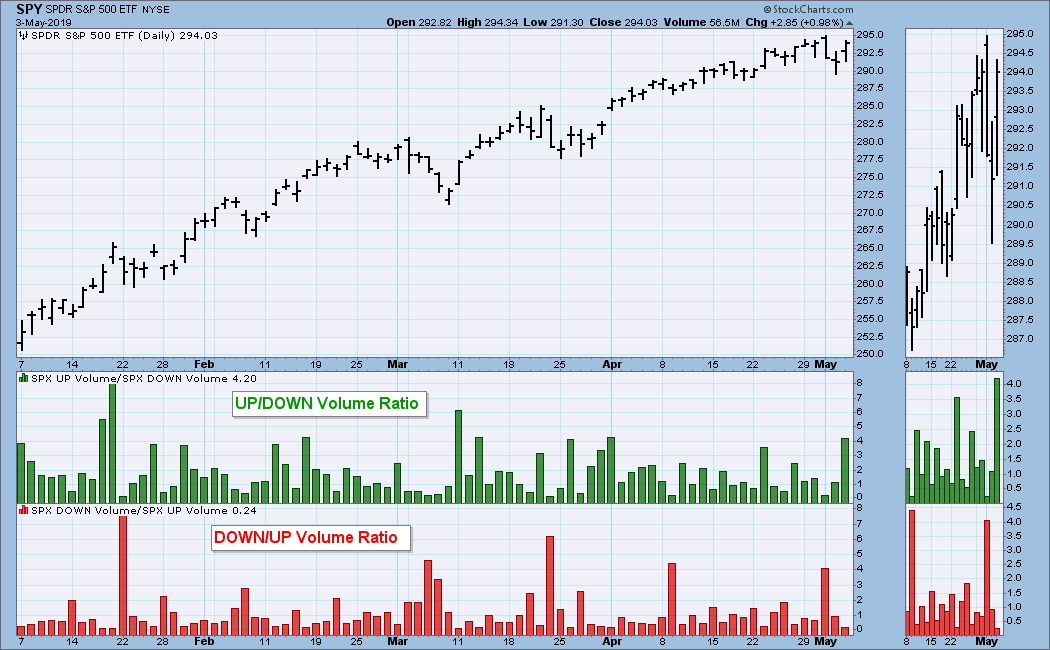
You can see that, in Carl's annotations, the readings are very climactic. Compare the ratios. The short-term chart above shows ratios that are less than 5.0. The chart below shows climactic readings above 370!

Below is an even longer-term chart. Note that the extraordinarily climactic readings tend to arrive on point.
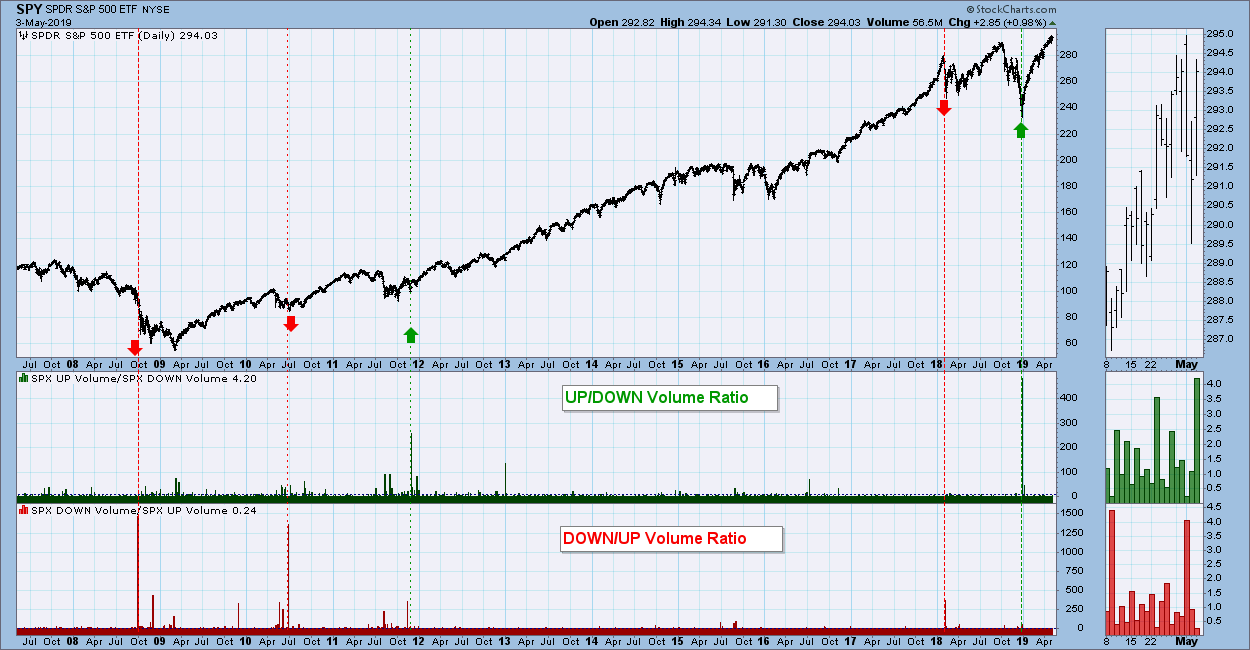
Below is a shorter-term chart of the NYSE's volume ratios. Readings above 20 have had significance in relation to price bottoms and last year's top.
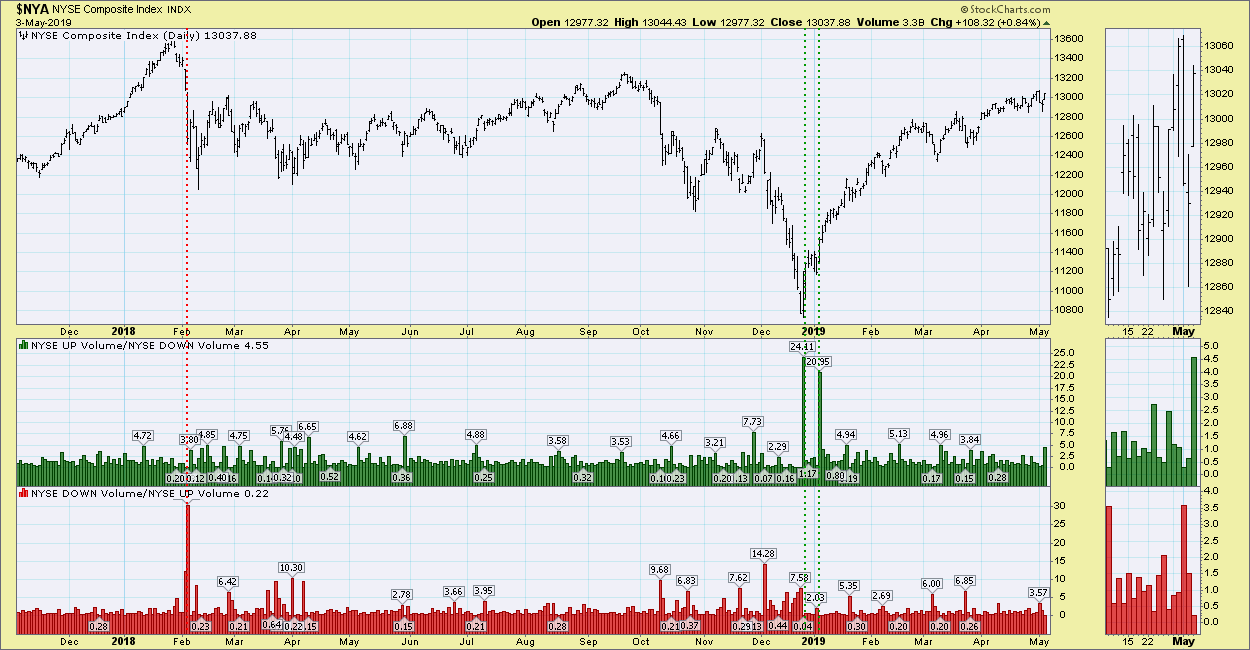
Conclusion: If you are interested in downloading the DecisionPoint Market Indicator ChartPack, instructions are here. For Basic members, you can click on the charts above to save them to your ChartList.
Watch the latest episode of DecisionPoint with Carl & Erin Swenlin LIVE on Fridays 4:30p EST or on the StockCharts TV YouTube channel here!
Technical Analysis is a windsock, not a crystal ball.
Happy Charting!
- Erin
erinh@stockcharts.com
Helpful DecisionPoint Links:
Erin's PMO Scan
DecisionPoint Chart Gallery
Trend Models
Price Momentum Oscillator (PMO)
On Balance Volume
Swenlin Trading Oscillators (STO-B and STO-V)
ITBM and ITVM
SCTR Ranking
**Don't miss DecisionPoint Commentary! Add your email below to be notified of new updates"**
|
| READ ONLINE → |
|
|
|
| MORE ARTICLES → |
|


 Hello Fellow ChartWatchers!
Hello Fellow ChartWatchers! After our Spring Special ends, we'll send out an exclusive link with access to the latest StockChartsACP demo. The official release of ACP will come later this summer, but the newest technology preview will give you a taste of how powerful the platform will be. If you sign up for the Spring Special now, you'll receive your 2 free months of service AND access to this exciting new feature preview at the end of the sale!
After our Spring Special ends, we'll send out an exclusive link with access to the latest StockChartsACP demo. The official release of ACP will come later this summer, but the newest technology preview will give you a taste of how powerful the platform will be. If you sign up for the Spring Special now, you'll receive your 2 free months of service AND access to this exciting new feature preview at the end of the sale!

























